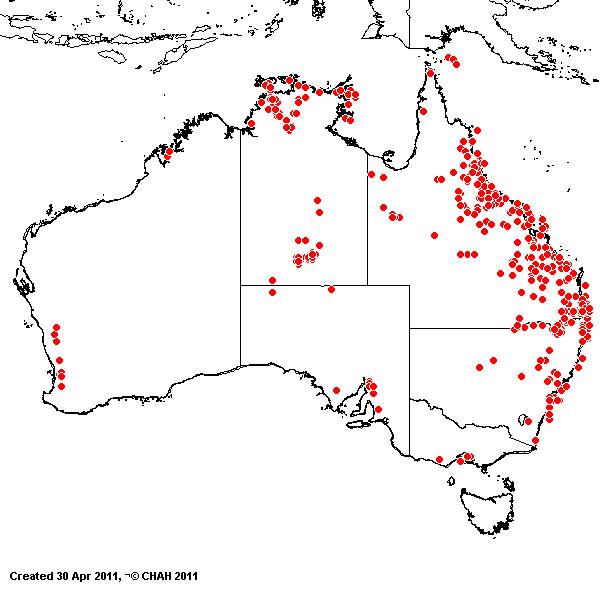Melinis repens* (Willdenow) G. Zizka. Bibl. Bot. 138: 55 (1988).
Classification. (GPWG 2001) : Subfamily Panicoideae. Paniceae.
Basionym and/or Replacement Name: Saccharum repens Willd., Sp. Pl. 1(1): 322 (1797).
Type of Basionym or Protologue Information: Africa: Ghana:, Isert s.n. [Thonning and other Danish Botanists] (HT: B-W-1499).
Recent synonyms: Rhynchelytrum repens.
Key references (books and floras): [1952] C.A.Gardner, Flora of Western Australia 1 Gramineae (274 as Rhynchelytrum repens), [1981] M.Lazarides in J.Jessop (ed)., Flora of Central Australia (481 as Rhynchelytrum), [2002] D.Sharp & B.K.Simon, AusGrass, Grasses of Australia, [2006] J.Jessop, G.R.M.Dashorst, F.M.James, Grasses of South Australia (456), [2008] S.W.L.Jacobs, R.D.B.Walley & D.J.B.Wheeler, Grasses of New South Wales (299).
Illustrations: [1952] C.A.Gardner, Flora of Western Australia 1 Gramineae (275, Pl.79 as Rhynchelytrum), [1984] N.T.Burbidge. rev. S.W.L.Jacobs, Australian Grasses (231 as Rhynchelytrum), [2006] J.Jessop, G.R.M.Dashorst, F.M.James, Grasses of South Australia (455, fig. 387), [2008] S.W.L.Jacobs, R.D.B.Whalley & D.J.B.Wheeler, Grasses of New South Wales, 4th edn (299).
Habit. Annual or perennial. Culms erect or geniculately ascending or decumbent, 20–150 cm tall. Ligule a fringe of hairs, 0.7–1.2 mm long. Leaf-blades flat or conduplicate, 3–30 cm long, 2–10 mm wide.
Inflorescence. Inflorescence compound, a panicle. Panicle oblong or ovate, 5–20 cm long.
Spikelets. Spikelets pedicelled. Fertile spikelets 2-flowered, the lower floret barren (rarely male), the upper fertile, comprising 1 basal sterile florets, comprising 1 fertile floret(s), without rachilla extension, ovate, laterally compressed, 2–12 mm long. Rhachilla internodes elongated between glumes.
Glumes. Glumes dissimilar, thinner than fertile lemma. Lower glume oblong, membranous, without keels, 0–1 -nerved. Lower glume surface indumented. Upper glume ovate, 3–5.3 mm long, chartaceous, without keels, 5 -nerved. Upper glume surface glabrous or indumented. Upper glume apex lobed, mucronate or awned. Florets. Basal sterile florets 1, male or barren, with palea. Lemma of lower sterile floret 100 % of length of spikelet, chartaceous, much thinner above, 5 -nerved, mucronate or awned.
Fertile lemma 2–2.5 mm long, without keel, 5 -nerved. Lemma surface glabrous. Palea without keels.
Continental Distribution: Africa, Temperate Asia, Tropical Asia, Australasia, Pacific, North America, and South America.
Australian Distribution: Western Australia, Northern Territory, South Australia, Queensland, New South Wales, Victoria, Lord Howe, Christmas Is.
Western Australia: Drummond, Menzies. Northern Territory: Darwin & Gulf, Central Australia South. South Australia: Flinders Ranges, Eyre Peninsula. Queensland: Burke, Burnett, Cook, Darling Downs, Gregory North, Leichhardt, Maranoa, Mitchell, Moreton, North Kennedy, Port Curtis, South Kennedy, Wide Bay. New South Wales: North Coast, Central Coast, South Coast, North-Western Slopes, Central-Western Slopes, North-Western Plains. Victoria: Volcanic Plain.
Notes. Easily distinguished by the red inflorescence. Diagnostic characteristics include the hairy spikelets, ciliate nerves of the lower palea and the sprawling habit of the flowering culms.
Native to Africa but introduced throughout the world. In tropical and subtropical rain forests, tropical and subtropical wet sclerophyll forests, dry sclerophyll forests, Brigalow forests, tropical and subtropical sub-humid woodlands, temperate sub-humid woodlands, semi-arid shrub woodlands, arid and semi-arid low woodlands, acacia shrublands, and coastal grasslands. In Australia, it is common in the non-arid regions. This species has little if any economic importance. Flowers collected sporadically throughout the year.



